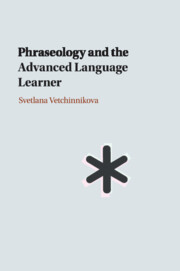Book contents
- Phraseology and the Advanced Language Learner
- Phraseology and the Advanced Language Learner
- Copyright page
- Contents
- Figures
- Tables
- Acknowledgements
- Abbreviations
- Chapter 1 Introduction
- Chapter 2 From a Unit of Meaning to a Meaning-Shift Unit
- Chapter 3 L2 Use and Processing of Multi-Word Units
- Chapter 4 Triangulating Usage, Exposure and Processing
- Chapter 5 Meaning-Shift Units in L2 Learning and Use: Usage vs. Exposure
- Chapter 6 Meaning-Shift Units in L2 Processing: Usage vs. Word Association Responses
- Chapter 7 Towards the Bigger Picture
- Book part
- References
- Index
Chapter 5 - Meaning-Shift Units in L2 Learning and Use: Usage vs. Exposure
Published online by Cambridge University Press: 18 November 2019
- Phraseology and the Advanced Language Learner
- Phraseology and the Advanced Language Learner
- Copyright page
- Contents
- Figures
- Tables
- Acknowledgements
- Abbreviations
- Chapter 1 Introduction
- Chapter 2 From a Unit of Meaning to a Meaning-Shift Unit
- Chapter 3 L2 Use and Processing of Multi-Word Units
- Chapter 4 Triangulating Usage, Exposure and Processing
- Chapter 5 Meaning-Shift Units in L2 Learning and Use: Usage vs. Exposure
- Chapter 6 Meaning-Shift Units in L2 Processing: Usage vs. Word Association Responses
- Chapter 7 Towards the Bigger Picture
- Book part
- References
- Index
Summary
Chapter 5 compares the phraseology of usage to exposure. It shows that more than half of patterns extracted from a student’s usage corpus also occur in her exposure corpus. At the same time the figure drops significantly if these patterns are compared to a different student’s exposure corpus supporting the assumption of representativeness. The chapter then proceeds to compare usage patterns to exposure qualitatively focusing on the processes of variation and change. It finds support for the process of approximation through which a more or less fixed pattern loosens and becomes variable on the semantic or grammatical axis presumably due to frequency effects and the properties of human memory. The chapter also proposes a reverse process, fixing, through which the pattern extends and develops verbatim associations through repeated usage. Both processes are suggested to occur within meaning-shifts units and thus be characteristic of co-selection.
Keywords
Information
- Type
- Chapter
- Information
- Phraseology and the Advanced Language Learner , pp. 101 - 152Publisher: Cambridge University PressPrint publication year: 2019
